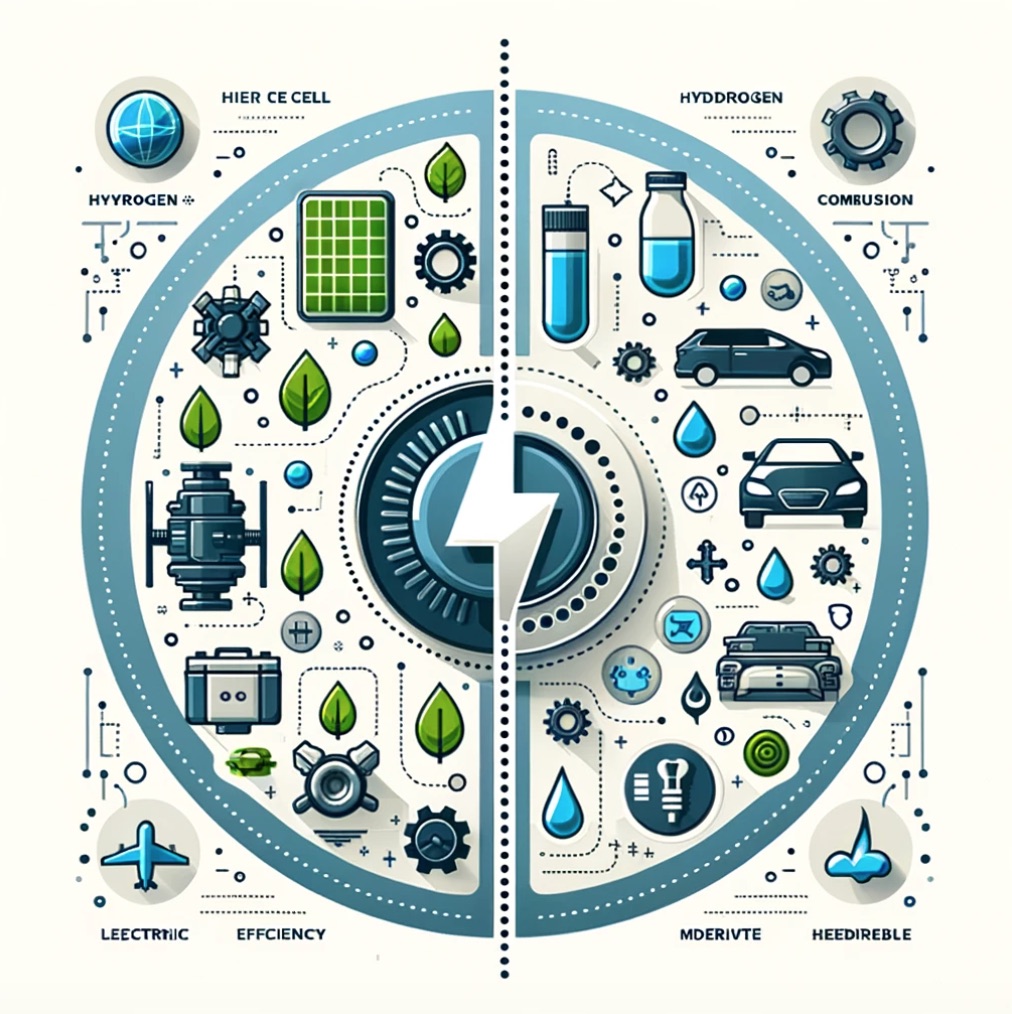The global energy landscape is witnessing a pivotal shift towards cleaner, more sustainable solutions to mitigate climate change and reduce reliance on fossil fuels. Hydrogen, with its high energy content and zero-emission capability when used, has emerged as a promising alternative. Among its applications, hydrogen fuel cells and hydrogen combustion engines are two technologies that harness hydrogen’s potential in different ways. This article delves into the nuances of both technologies, comparing their efficiency, environmental impact, applications, and future prospects.
Hydrogen Fuel Cell Technology
Overview: Hydrogen fuel cells generate electricity through a chemical reaction between hydrogen and oxygen, producing water and heat as byproducts. This technology is known for its high efficiency and zero-emission profile when the hydrogen used is produced from renewable sources.
Efficiency and Environmental Impact: Fuel cells are inherently more efficient than internal combustion engines, often exceeding 60% efficiency under optimal conditions. This efficiency translates into higher fuel economy and lower greenhouse gas emissions, provided the hydrogen is sourced sustainably. Moreover, since the only byproduct of the electricity generation process in fuel cells is water, they offer a significant environmental advantage, particularly in urban settings where air quality is a concern.
Applications: The primary application of hydrogen fuel cells is in the transportation sector, notably in passenger vehicles, buses, and heavy-duty trucks. Beyond transportation, they are also used in stationary power generation and backup power systems, offering a clean alternative to diesel generators.
Hydrogen Combustion Engine Technology
Overview: Hydrogen combustion engines work on the same principle as traditional internal combustion engines but use hydrogen as fuel instead of gasoline or diesel. These engines combust hydrogen to produce mechanical power, with water vapor being the primary emission.
Efficiency and Environmental Impact: While hydrogen combustion engines emit only water vapor when burning hydrogen, their efficiency is generally lower than that of fuel cells. The thermal efficiency of hydrogen engines can range from 25% to 30%, which is comparable to or slightly better than gasoline engines. However, NOx emissions (nitrogen oxides) can be a concern due to the high combustion temperatures, necessitating sophisticated emission control technologies.
Applications: Hydrogen combustion engines can be retrofitted into existing vehicle platforms, allowing for a relatively straightforward transition from fossil fuels to hydrogen in sectors like transportation. They are particularly appealing for applications where high energy density and rapid refueling are critical, such as in aviation and certain types of shipping.
Comparison and Future Prospects
Comparative Analysis: The choice between hydrogen fuel cells and hydrogen combustion engines largely depends on the specific application and priorities in terms of efficiency, environmental impact, and infrastructure requirements. Fuel cells offer higher efficiency and lower environmental impact but come with challenges related to hydrogen storage and the need for a more extensive refueling infrastructure. Hydrogen combustion engines, while less efficient, can leverage existing internal combustion engine technologies and refueling infrastructures, albeit with modifications to handle hydrogen.
Future Prospects: The future of hydrogen in energy systems looks promising, with both technologies playing pivotal roles in different niches. Hydrogen fuel cells are gaining traction in the automotive industry, with several manufacturers committing to fuel cell vehicles. Meanwhile, hydrogen combustion engines are being explored as a viable option for sectors where battery-electric solutions are less feasible, such as long-haul transportation and aviation.
The development of a green hydrogen economy, focusing on hydrogen production from renewable energy sources, will be crucial for both technologies to realize their full environmental benefits. Investments in hydrogen infrastructure, research into improving efficiency and reducing costs, and supportive policy frameworks are key to accelerating the adoption of hydrogen technologies.
Below is a comparison table that outlines the key differences between Hydrogen Fuel Cell Technology and Hydrogen Combustion Engine Technology, focusing on several critical aspects:
| Feature |
Hydrogen Fuel Cell Technology |
Hydrogen Combustion Engine Technology |
| Principle of Operation |
Generates electricity through a chemical reaction between hydrogen and oxygen. |
Burns hydrogen in an internal combustion engine to produce mechanical power. |
| Efficiency |
High (often exceeding 60% under optimal conditions) |
Lower compared to fuel cells (25% to 30%, similar to or slightly better than gasoline engines) |
| Environmental Impact |
Zero emissions at the point of use (emits only water when hydrogen is sourced sustainably) |
Low emissions (emits only water vapor, but NOx emissions can be a concern due to high combustion temperatures) |
| Applications |
Transportation (e.g., passenger vehicles, buses, trucks), stationary power generation, backup power systems |
Transportation (can be retrofitted into existing vehicle platforms), aviation, certain types of shipping |
| Infrastructure Requirements |
Requires development of hydrogen refueling infrastructure |
Can leverage existing fueling infrastructure with modifications for hydrogen; easier retrofitting into existing ICE vehicles |
| Cost and Market Readiness |
High initial costs for technology and infrastructure, but decreasing with advancements and scale |
Lower initial costs due to compatibility with existing internal combustion engine technologies, but requires investment in emission control technologies |
| Future Prospects |
Increasing adoption in automotive and other sectors; dependent on advancements in hydrogen production and infrastructure development |
Seen as a transitional technology; potential use in sectors where battery-electric solutions are less feasible |
This table provides a snapshot of the current state and considerations for each technology. Both hydrogen fuel cells and hydrogen combustion engines have their roles in the transition to a sustainable energy future, with their adoption depending on specific application needs, economic factors, and technological advancements.
Conclusion
Hydrogen stands at the forefront of the transition to a cleaner energy future, with hydrogen fuel cells and hydrogen combustion engines offering complementary pathways for its utilization. While fuel cells offer greater efficiency and environmental benefits, combustion engines provide a practical transition strategy by adapting existing technologies and infrastructures for hydrogen use. The choice between them will be dictated by application-specific requirements, economic considerations, and the pace of technological advancements and infrastructure development. As the global community continues to prioritize sustainability, both technologies will undoubtedly play crucial roles in shaping a zero-emission, hydrogen-powered world.







